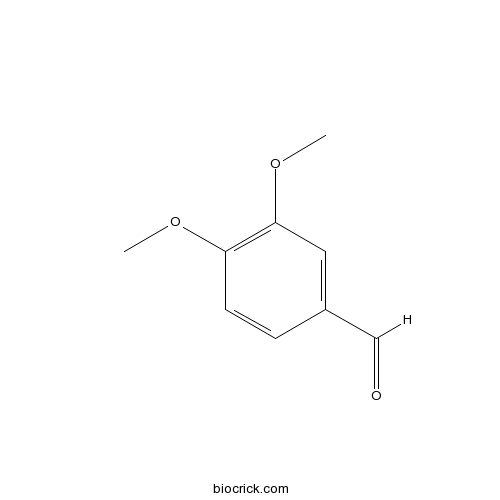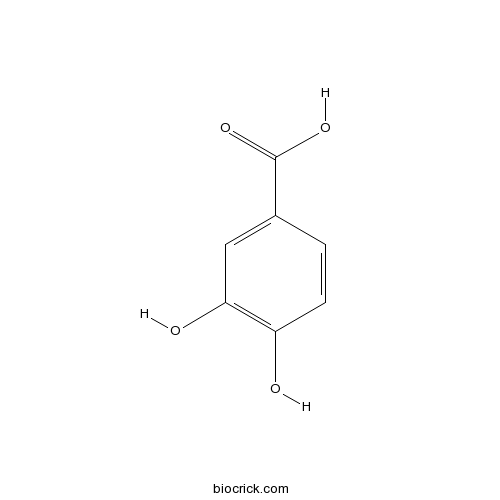Sorbaria sorbifolia
Sorbaria sorbifolia
1. The products in our compound library are selected from thousands of unique natural products; 2. It has the characteristics of diverse structure, diverse sources and wide coverage of activities; 3. Provide information on the activity of products from major journals, patents and research reports around the world, providing theoretical direction and research basis for further research and screening; 4. Free combination according to the type, source, target and disease of natural product; 5. The compound powder is placed in a covered tube and then discharged into a 10 x 10 cryostat; 6. Transport in ice pack or dry ice pack. Please store it at -20 °C as soon as possible after receiving the product, and use it as soon as possible after opening.
Natural products/compounds from Sorbaria sorbifolia
- Cat.No. Product Name CAS Number COA
-
BCN6089
Veratraldehyde120-14-9
Instructions

-
BCN4537
3,4-Dihydroxybenzoic acid99-50-3
Instructions

TTF1-NPs Induce ERS-Mediated Apoptosis and Inhibit Human Hepatoma Cell Growth In Vitro and In Vivo.[Pubmed: 27931287]
Previous studies have shown that 5,2,4-trihydroxy-6,7,5-trimethoxyflavone (TTF1) is the primary anticancer constituent of the traditional Chinese medicinal plant Sorbaria sorbifolia (SS), which has been applied to treat cancer in China. In this study, we investigated the in vitro and in vivo antitumor effects and biological mechanisms of small-molecule TTF1 nanoparticles (TTF1-NPs). The effects of TTF1-NPs on cell growth and apoptosis were investigated using human hepatoma cells. The molecular changes associated with the effects of TTF1-NPs were analyzed by immunocytochemistry and Western blot analysis. The in vivo effect of TTF1-NPs was investigated using the HepG2 tumor xenograft model. We found that TTF1-NPs exhibited antitumor effects in vitro accompanied by induction of apoptosis in human hepatoma cells. Mechanistically, our data showed that TTF1-NPs induced apoptosis via endoplasmic reticulum stress (ERS) pathway in hepatoma cells. Moreover, inhibition of ERS activation blocked TTF1-NP-induced apoptosis in HepG2 cells. Finally, TTF1-NPs inhibited the growth of HepG2 xenograft tumors. Taken together, our results demonstrated that TTF1-NP-induced apoptosis was mediated at least in part by the ERS pathway and thus inhibited hepatoma tumor growth.
Differences in ozone sensitivity among woody species are related to leaf morphology and antioxidant levels.[Pubmed: 27217527]
Ozone (O3) sensitivity varies greatly among plant species. Leaf traits such as stomatal conductance, antioxidant capacity and leaf morphology and anatomy may play important roles in controlling this variation, but the relative contributions of each trait remain elusive. In this study, we examined the differences in O3 sensitivity among 29 deciduous and evergreen woody species used for urban greening in China in an open-top chamber experiment. Elevated O3 caused visible injury and reductions in net photosynthesis, and these effects differed significantly among species. The deciduous species Sorbaria sorbifolia, Hibiscus syriacus and Fraxinus chinensis were the most sensitive, while evergreen species ranked among the most tolerant. O3 sensitivity was linked to both low leaf mass per area (LMA) and low leaf area-based antioxidant levels, but not to variation in leaf mass-based antioxidant levels or stomatal conductance. The well-known and easily measured leaf trait LMA thus represents a potentially useful metric for O3 risk assessment and for selecting appropriate species for urban greening in O3-polluted areas.
TTF1-NPs Induce ERS-Mediated Apoptosis and Inhibit Human Hepatoma Cell Growth In Vitro and In Vivo.[Pubmed: 27131317]
Previous studies have shown that 5,2',4'-trihydroxy-6,7,5'-trimethoxyflavone (TTF1) is the primary anticancer constituent of the traditional Chinese medicinal plant Sorbaria sorbifolia (SS), which has been applied to treat cancer in China. In this study, we investigated the in vitro and in vivo antitumor effects and biological mechanisms of small-molecule TTF1 nanoparticles (TTF1-NPs). The effects of TTF1-NPs on cell growth and apoptosis were investigated using human hepatoma cells. The molecular changes associated with the effects of TTF1-NPs were analyzed by immunocytochemistry and Western blot analysis. The in vivo effect of TTF1-NPs was investigated using the HepG2 tumor xenograft model. We found that TTF1-NPs exhibited antitumor effects in vitro accompanied by induction of apoptosis in human hepatoma cells. Mechanistically, our data showed that TTF1-NPs induced apoptosis via endoplasmic reticulum stress (ERS) pathway in hepatoma cells. Moreover, inhibition of ERS activation blocked TTF1-NP-induced apoptosis in HepG2 cells. Finally, TTF1-NPs inhibited the growth of HepG2 xenograft tumors. Taken together, our results demonstrated that TTF1-NP-induced apoptosis was mediated at least in part by the ERS pathway and thus inhibited hepatoma tumor growth.
Leucine-derived cyanoglucosides from the aerial parts of Sorbaria sorbifolia (L.) A. Braun.[Pubmed: 27060709]
Six new cyanoglucosides, 2S-cardiospermin-5-benzoate (1), 2R-cardiospermin-5-p-hydroxybenzoate (2), 2S-cardiospermin-5-cis-p-coumarate (3), isocardiospermin-5-p-hydroxybenzoate (4), sutherlandin-5-p-hydroxybenzoate (5), and sutherlandin-5-cis-p-coumarate (6), together with 17 known compounds were isolated from Sorbaria sorbifolia. The structures of the new compounds were elucidated by extensive spectroscopic methods, including 1D and 2D NMR, HR-ESI-MS and ECD experiments. The biosynthetic relationship of 1-9 was also discussed. The cyanoglucosides (1-9) and 15 exhibited moderate inhibitory effect on nitric oxide production of RAW264.7 macrophages stimulated by lipopolysaccharide (LPS).
Particulate matter on foliage of 13 woody species: deposition on surfaces and phytostabilisation in waxes--a 3-year study.[Pubmed: 23488010]
Particulate matter (PM) as an air pollutant can be harmful for human health through allergic, mutagenic and carcinogenic effects. Although the main focus is on decreasing air pollution, after PM has been emitted to the atmosphere, one ofthe realistic options to decrease it's concentrations in urbanized area will be phytoremediation. This study compared the capacity to capture PM from air of seven tree species commonly cultivated in Poland (Catalpa bignonioides Walter, Corylus colurna L., Fraxinus pennsylvanica Marsh., Ginkgo biloba L., Platanus x hispanica Mill. ex Muenchh., Quercus rubra L., Tilia tomentosa Moench 'Brabant') and six shrub species (Acer tataricum subsp, ginnala (Maxim.) Wesm., Sambucus nigra L., Sorbaria sorbifolia (L) A.Br., Spiraea japonica L.f., Syringe meyeri C.K. Schneid. 'Palibin', Viburnum lantana L.). Significant differences were found between species in mass of total PM accumulation for two PM categories and three size fractions determined and in amount of waxes. A positive correlation was found between in-wax PM of diameter 2.5-10 microm and amount of waxes, but not between amount of waxes and amount of total PM or of any size fraction.
[Dynamics and modeling of water content of ten shrub species in their growth period in Maoershan Mountain region of Northeast China].[Pubmed: 23479872]
Based on the two successive years observation of the water content of ten representative shrub species in Maoershan Mountain region of Northeast China, this paper studied the dynamics of the water content of these shrub species during their growth period and related affecting factors, with the prediction models of the shrub water content established. For the ten shrub species, their minimal water content during growth period was higher than 100% , and most of the species had a water content higher than 200% within the period from the late phase of leaf-unfolding to early phase of leaf-falling. Euonymus verrucosus, Sorbaria sorbifolia, and Sambucus williamsii were incombustible in their whole growth period due to the extremely high water content, while Syringa reticulate, Philadelphus schrenkii, Euonymus verrucosus, Spiraea chamaedryfolia, Lonicera maackii, Lonicera ruprechtiana, and Rhamnus parvifolia were combustible only in the phases of budding and leaf-falling. Soil moisture content and daily maximum temperature had effects on the water content of most (7) of the ten shrubs, and canopy drought severity index affected the water content of 5 of the ten shrubs. The established 9 prediction models could explain more than 35% of the water content variance of the shrub species, with a mean MRE of 35.9% and a mean MRE of 13.4%.
Eriophyoid mites from Northeast China (Acari: Eriophyoidea).[Pubmed: 26146687]
We describe and illustrate herein one new genus and eighteen new eriophyoid mite species (Acari: Eriophyoidea) collected in northeast China. They are: Shevtchenkella huzhongiensis sp. nov. on Ulmus davidiana Planch. var. japonica (Sarg. ex Rehder) Nakai (Ulmaceae), Shevtchenkella jingboicus sp. nov. on Acer sp. (Aceraceae), Calepitrimerus flexuosus sp. nov. on Spiraea flexuosa Fisch. ex Cambess. (Rosaceae), Calepitrimerus maximowiczii sp. nov. on Crataegus maximowiczii Schneid. (Rosaceae), Calepitrimerus pilosus sp. nov. on Agrimonia pilosa Ledeb. (Rosaceae), Calepitrimerus yichunensis sp. nov. on Sorbaria sorbifolia (L.) A.Br. (Rosaceae), Cupacarus oxyphyllus sp. nov. on Euonymus oxyphyllus Miq. (Cel-astraceae), Epitrimerus sambucus sp. nov. on Sambucus williamsii Hance (Caprifoliaceae), Epitrimerus wuyingensis sp. nov. on Acer sp. (Aceraceae), Longisolenidionus amurensis gen. nov & sp. nov. on Tilia amurensis Rupr. (Tiliaceae), Phyllocoptes jiagedaqiensis sp. nov. on Cunninghamia sp. (Taxodiaceae), Aculops huzhongensis sp. nov. on Salix sp. (Sali-caceae), Aculus huzhongsalixus sp. nov. on Salix sp. (Salicaceae), Tetra angelica sp. nov. on Angelica sp. (Apiaceae), Tetra jiagedaqia sp. nov. on Lespedeza sp. (Fabaceae), Vittacus mandshurica sp. nov. on Corylus sieboldiana Blume var. mandshurica (Maxim.) C. K. Schneid. (Betulaceae), Vittacus cannabus sp. nov. on Cannabis sativa L. (Moraceae), and Peralox dentatis sp. nov. on Ulmus sp. (Ulmaceae). Two species formerly assigned to Rhyncaphytoptus, R. abiesis (Xue, Song & Hong, 2006) and R. fabris (Xue, Song & Hong, 2006) were reassigned to Nalepella, based on the presence of seta vi on the apical shield, and other characteristics of Nalepella. One species formerly assigned to Rhyncaphytoptus, R. fargesis (Xue, Song & Hong, 2006) was reassigned to Pentaporca, based on the presence of seta vi on the apical shield, opisthosoma with five ridges and other characteristics of Pentaporca. At the same time, four new eriophyoid mite records from China are provided, Acaphyllisa distasa (Keifer, 1961) rec. nov. on Betula costata Trautv. (Betulaceae), Shevtchenkella ulmi (Farkas, 1960) rec. nov. on Ulmus sp. (Ulmaceae), Calepitrimerus cariniferus Keifer, 1938, rec. nov. on Artemisia argyi H. Lev. & Vaniot (Asteraceae), Aculodes dubius (Nalepa, 1891) species complex, rec. nov. on Roegneria sp. (Poaceae). With this publication, the number of eriophyoid mite species in the region reaches 101. A list of these eriophyoid mites is provided.
Inhibition of tumor angiogenesis by TTF1 from extract of herbal medicine.[Pubmed: 22171128]
To study the inhibition of tumor angiogenesis by 5,2,4´-trihydroxy-6,7,5´-trimethoxyflavone (TTF1) isolated from an extract of herbal medicine Sorbaria sorbifolia.


